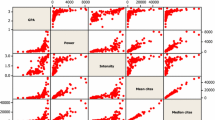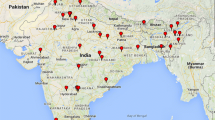Abstract
A bibliometric analysis of the 50 most frequently publishing Spanish universities shows large differences in the publication activity and citation impact among research disciplines within an institution. Gini Index is a useful measure of an institution’s disciplinary specialization and can roughly categorize universities in terms of general versus specialized. A study of the Spanish academic system reveals that assessment of a university’s research performance must take into account the disciplinary breadth of its publication activity and citation impact. It proposes the use of graphs showing not only a university’s article production and citation impact, but also its disciplinary specialization. Such graphs constitute both a warning and a remedy against one-dimensional approaches to the assessment of institutional research performance.




Similar content being viewed by others
References
Aguillo, I. F., Ortega, J. L., & Fernández, M. (2008). Webometric ranking of World Universities: introduction, methodology, and future developments. Higher Education in Europe, 33(2/3), 234–244.
AUBR (2009). Expert Group on the Assessment of University-Based Research. Assessing Europe’s University-Based Research. European Commission—DG Research. http://ec.europa.eu/euraxess/index_en.cfm?l1=23&l2=0&l3=1&newsletter=18_02.
Burrell, Q. L. (1991). The Bradford distribution and the Gini index. Scientometrics, 21(2), 181–194.
Calero-Medina, C., López-Illescas, C., Visser, M. S., & Moed, H. F. (2008). Important factors in the interpretation of bibliometric rankings of world universities. Research Evaluation, 17, 71–81.
CEPES (2006). The Berlin Principles on Ranking of Higher Education Institutions. http://www.che.de/downloads/Berlin_Principles_IREG_534.pdf. Accessed 11 January 2009.
CL-CSIC (2009). Ranking Web of World Universities, Cybermetrics Lab CSIC. http://www.webometrics.info/. Accessed 22 July 2009.
CWTS (2009). Leiden World Ranking, Centre for Science and Technology Studies, University of Leiden. http://www.cwts.nl/ranking/LeidenRankingWebsite.html. Accessed 22 July 2009.
Egghe, L., & Rousseau, R. (1990). Introduction to Informetrics. Amsterdam: Elsevier.
Halffman, W., & Leydesdorff, L. (2010). Is inequality among universities increasing? Gini coefficients and the elusive rise of elite universities. Minerva, 48(1), 55–72.
HEEACT (2009). Performance Ranking of Scientific Papers for World Universities, Higher Education Evaluation and Accreditation Council of Taiwan. http://ranking.heeact.edu.tw/en-us/2008/page/Background. Accessed 22 July 2009.
IREG (2009). International Observatory on Academic Rankings and Excellence. http://www.ireg-observatory.org/index.php?option=com_frontpageandItemid=1. Accessed 22 July 2009.
Liu, N. C., & Cheng, Y. (2005). The academic ranking of world universities—methodologies and problems. Higher Education in Europe, 30(2), 127–136.
Liu, N. C., & Cheng, Y. (2008). Examining major rankings according to the Berlin principles. Higher Education in Europe, 33(2/3), 201–208.
Moed, H. F., van Leeuwen, Th. N., & Visser, M. S. (1999). Trends in publication output and impact of universities in the Netherlands. Research Evaluation, 8, 60–67.
Persson, O., & Melin, G. (1996). Equalization, growth and integration of science. Scientometrics, 37(1), 153–157.
Rousseau, R. (1992a). Concentration and diversity measures in informetric research. Ph.D. Thesis, University of Antwerp, Antwerp.
Rousseau, R. (1992b). Specialization and Diversity in Informetric Research. Ph.D. Thesis, University of Antwerp, Antwerp.
Salmi, J. (2009) The Challenge of Establishing World-Class Universities, World Bank: Washington.
SCImago (2010). The SIR 2009 World Report. http://www.scimagoir.com/. Accessed 8 August 2010.
Scopus (2010). What does it cover? http://info.scopus.com/scopus-in-detail/facts/. Accessed 8 August 2010.
SJTU (2007). Academic Ranking of World Universities, Shanghai Jiao Tong University. http://www.arwu.org/rank/2007/ranking2007.htm. Accessed 22 July 2009.
Times QS (2009). Times QS World University Rankings. http://www.topuniversities.com/worlduniversityrankings/university_rankings_home/. Accessed 22 July 2009.
Van Raan, A. F. J. (2005). Fatal attraction—conceptual and methodological problems in the ranking of universities by bibliometric methods. Scientometrics, 62(1), 133–143.
Author information
Authors and Affiliations
Corresponding author
Rights and permissions
About this article
Cite this article
López-Illescas, C., de Moya-Anegón, F. & Moed, H.F. A ranking of universities should account for differences in their disciplinary specialization. Scientometrics 88, 563–574 (2011). https://doi.org/10.1007/s11192-011-0398-6
Received:
Published:
Issue Date:
DOI: https://doi.org/10.1007/s11192-011-0398-6




